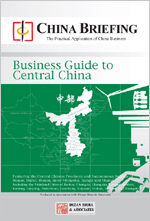Wuhan’s Time Has Come – City Business Overview
Nov. 14 – Wuhan, the central Chinese inland capital city of Hubei province, has been generating interest recently as a major recipient of much of China’s stimulus package and also as an increasingly attractive recipient of foreign investment looking to sell further onto the domestic market. It is the seventh largest city in the country and is strategically placed as a logistics center in central China. Its position on the Yangtze River, with capabilities of handling 40 million tons of cargo annually also makes it attractive as it’s possible to manufacture here and ship downriver to primary markets such as Shanghai.
Certainly, the infrastructure already in place is impressive. Wuhan’s airport, China’s fourth largest, handles 120 flights a day, including to international destinations across Asia such as Japan, Korea, Thailand, Singapore and Hong Kong. Its second terminal has just been completed, giving it a capacity of a further 160 routes and annual cargo handling capacity of 320,000 tons when it becomes fully operational in the next two months.
Wuhan’s position on the Yangtze River also gives it a boost, despite being inland. Wuhan Harbor ships goods directly to 14 countries including Russia and all of Southeast Asia. With six terminals, and direct access upstream to Chongqing (and the massive markets in Sichuan province with a population of over 90 million) and the wealthy markets of Shanghai, the port is set to be further expanded. A feature of the Three Gorges Dam project has been to see water levels rise along the Yangtze, making it easier to navigate for larger vessels of up to 10,000 tons. Port capacity is set to reach 500,000 TEUs in the next twelve months.
 Wuhan is also well connected by rail and road. The city is one of the seven transnational hubs in China where north-south and east-west rail corridors interconnect. It is thus connected with direct trains to 25 of China’s provincial capitals. The city’s GDP reached RMB314.15 billion last year, with a 10.1 percent increase anticipated for 2008.
Wuhan is also well connected by rail and road. The city is one of the seven transnational hubs in China where north-south and east-west rail corridors interconnect. It is thus connected with direct trains to 25 of China’s provincial capitals. The city’s GDP reached RMB314.15 billion last year, with a 10.1 percent increase anticipated for 2008.
For more on Wuhan, including demographics on population, GDP, per capita income, retail sales, the economic and investment climate, and details on the free trade ports and development zones, please download this complimentary pdf file by clicking on the image at the right.
Note: Only China Briefing subscribers can access this pdf. If you are not yet a subscriber, please create an account, subscription is complimentary. We will also provide you with a copy of our monthly magazine and weekly China business investment updates.
 The Wuhan pdf was extracted from the new, best selling China Briefing Business Guide to Central China, 118 pages, full color, featuring the provinces and autonomous regions of Henan, Hubei, Hunan, Inner Mongolia, Jiangxi and Shanxi, and the cities of Baotou, Changde, Changsha, Datong, Hohhot, Kaifeng, Louyang, Manzhouli, Nanchang, Taiyuan, Wuhan, Yichang and Zhengzhou. It is priced at US$25 plus p&p and available from the China Briefing Bookstore or via sales@china-briefing.com.
The Wuhan pdf was extracted from the new, best selling China Briefing Business Guide to Central China, 118 pages, full color, featuring the provinces and autonomous regions of Henan, Hubei, Hunan, Inner Mongolia, Jiangxi and Shanxi, and the cities of Baotou, Changde, Changsha, Datong, Hohhot, Kaifeng, Louyang, Manzhouli, Nanchang, Taiyuan, Wuhan, Yichang and Zhengzhou. It is priced at US$25 plus p&p and available from the China Briefing Bookstore or via sales@china-briefing.com.
- Previous Article Current VAT ‘Encouraged Projects’ to Change Under New Tax Reform
- Next Article World Leaders Vow to Act on Crisis









